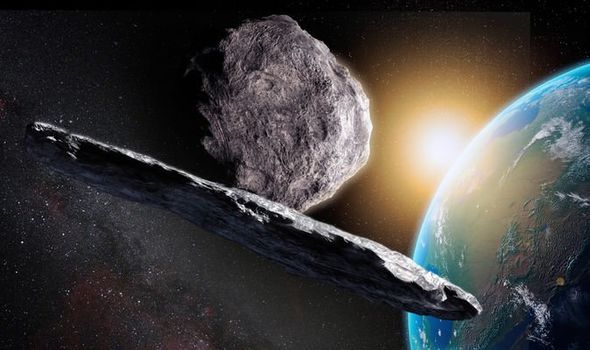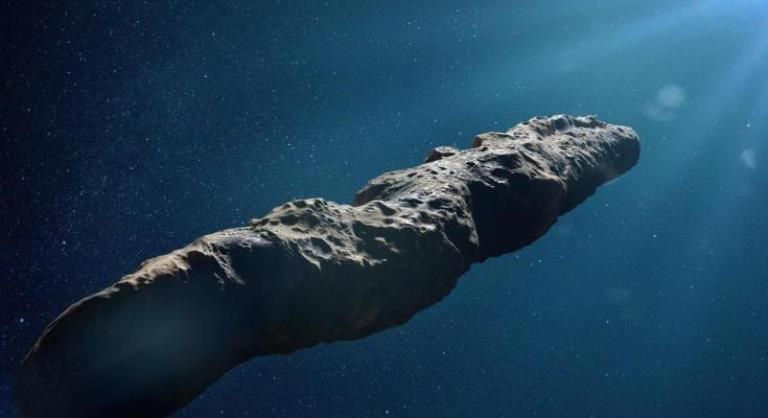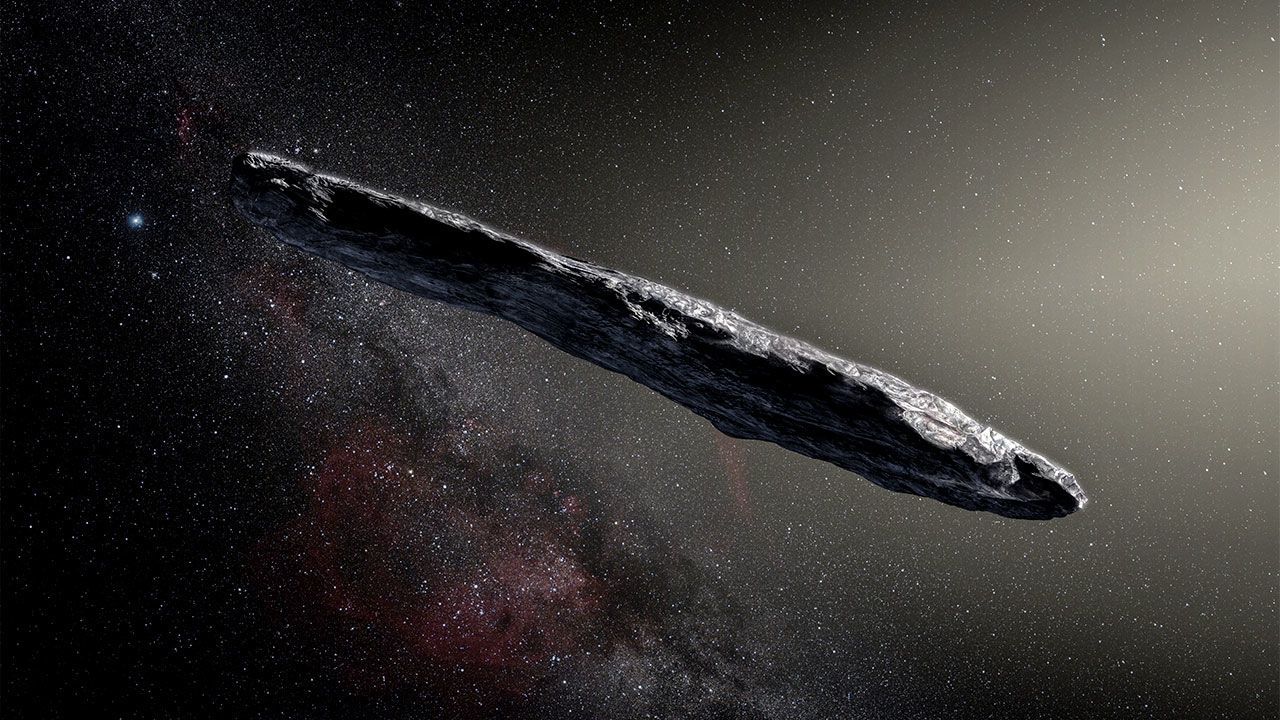The Pitfalls of Searching for Alien Life
Listen to “E32 7-15-19 The Pitfalls of Searching for Alien Life” on Spreaker.
by Diane Peters July 3, 2019 (thewire.in)
• In October 2017, a telescope at the University of Hawaii picked up a cigar-shaped object which had sling-shotted past the sun at 196,000 miles per hour. Scientists at the university dubbed it ‘Oumuamua’, Hawaiian for scout (depicted above). At first it was labeled an asteroid, and then a comet, but it certainly came from another solar system.
• Avi Loeb, the chair of Harvard University’s astronomy department, and Shmuel Bialy, a postdoctoral fellow at Harvard, published a paper in The Astrophysical Journal Letters theorizing that the object could be “light sail”, floating in interstellar space as debris from advanced technological equipment. “Alternatively,” they wrote, “a more exotic scenario is that Oumuamua may be a fully operational probe sent intentionally to Earth vicinity by an alien civilization.”
• While scientists theorizing about alien life may find a rapt public audience, they can also draw cynical, even hostile reactions from their fellow scientists. Paul Sutter, an astrophysicist at Ohio State University, tweeted: “No, ‘Oumuamua is not an alien spaceship, and the authors of the paper insult honest scientific inquiry to even suggest it.” Or they may draw sarcasm, as Neil deGrasse Tyson once quipped to CNN: “Call me when you have a dinner invite from an alien.”
• The threat of being written off as a kook looms large for researchers. Many academics “won’t touch it with a ten-foot pole,” said Don Donderi, a retired associate professor of psychology at McGill University in Montreal who now teaches a non-credit course called “UFOs: History and Reality” in the school’s continuing education department. No one at McGill seemed to mind when Donderi began writing about the paranormal in the 1970’s. But when he applied for a grant to investigate UFO sightings he was rejected. At his retirement, Donderi offered to give a free seminar on his UFO and alien abduction research, and was again turned down.
• Donderi notes that people who speak at UFO conferences “aren’t all equally good enough.” Meanwhile, those engaged in the search through bona fide organizations have come up with minimal results. Astronomers have been trying to communicate with alien life using radio waves since 1959, work that has continued by the SETI Institute to the present, but have found nothing. As a psychologist, Donderi believes that cognitive dissonance keeps the search for ET intelligence in limbo. “[A]cademics will bristle at conclusions that point to aliens,” says Donderi.
• Physicist Richard Bower of Durham University in England studies parallel universes. “We used to say that life is incredibly rare and we’re lucky to live on a habitable planet,’’ Bower said. “But we’ve now observed so many planets that are plausible habitats. It seems, based on scientific evidence, there’s no reason to think that planets like the Earth are rare.” Still, Bower is “less comfortable” with excessive speculation. Simply looking for alien life is too binary: if you don’t find it, you’ve got nothing. It is better to focus on questions that we may soon have the evidence to answer.
• We may be finding nothing because we’re doing it wrong. NASA physicist Silvano Colombano maintains that long-held assumptions have limited the earnest search for extraterrestrial intelligence, and that the “general avoidance of the subject by the scientific community” means no one questions them. Colombano suggests the search for alien intelligence is based on “cherished assumptions” that are holding it back, e.g.: that interstellar travel is unlikely, that alien civilizations use radio waves, that other life must be carbon-based, and that UFOs have never visited earth. Colombano makes a case for discarding these dusty beliefs, and instead imagine how alien societies’ technology might have evolved.
• Donderi concludes that the evidence is rising and feels that cognitive dissonance is at the moment collapsing. “[W]e’re at the beginning of the change,” he stated. Researchers expect more data about interstellar objects when the Large Synoptic Telescope in Chile starts operating in 2022.
In October 2017, a telescope operated by the University of Hawaii picked up a strange cigar-shaped object (artist rendering in top image), which had slingshotted past the sun at a more-than-brisk top speed of 196,000 miles per hour. Scientists at the university dubbed it ‘Oumuamua, Hawaiian for scout, and at first labelled it an asteroid, then a comet, but agreed that it came from another solar system.

Around the world, telescopes were quickly aimed toward ‘Oumuamua’s path, and scientists dove into the data. One of them, Avi Loeb, the chair of Harvard University’s astronomy department, published a paper in The Astrophysical Journal Letters the following year theorising that the object could be artificial. “Considering an artificial origin, one possibility is that ‘Oumuamua is a light sail, floating in interstellar space as a debris from advanced technological equipment,” he and co-author Shmuel Bialy, a postdoctoral fellow at Harvard, wrote. “Alternatively, a more exotic scenario is that ‘Oumuamua may be a fully operational probe sent intentionally to Earth vicinity by an alien civilisation.”

That’s not something you read every day in a serious scientific journal. The paper went viral, and Loeb began fielding an onslaught of media calls while fellow scientists weighed in. In terms of his colleagues’ reaction, Loeb said, “almost all of them reacted favourably, and they thought, you know, it’s just an interesting idea.”
Even so, he added, there were some adverse reactions as well. One cutting tweet by Paul Sutter, an astrophysicist at Ohio State University, reads: My publicist asked me for a quote on the ‘Oumuamua story making the rounds. Here it is:
“No, ‘Oumuamua is not an alien spaceship, and the authors of the paper insult honest scientific inquiry to even suggest it.”

Feel free to use that, @fcain, @tariqjmalik! — Paul M. Sutter (@PaulMattSutter) November 6, 2018
Also read: India Planning to Launch Own Space Station by 2030, ISRO Chief Says
All this hubbub took place in the aftermath of news reports that the Pentagon had been collecting data on UFO sightings for years. Clearly, the hunt for alien intelligence is alive and well in our solar system, and it’s hot news. Indeed, Loeb’s article was approved for publication in mere days.

But while scientists tossing around the idea of alien life may find a rapt public audience, they can also draw cynical, even hostile reactions from their fellow scientists, a response summed up by acclaimed physicist Neil deGrasse Tyson, who once quipped to CNN: “Call me when you have a dinner invite from an alien.”
This paradox has ripple effects. The threat of being written off as a kook can loom large for researchers, especially young ones. A lot of academics “won’t touch it with a ten-foot pole,” said Don Donderi, a retired associate professor of psychology at McGill University in Montreal who now teaches a non-credit course called “UFOs: History and Reality” in the school’s continuing education department.
Loeb says many discoveries have their roots in theories that were initially dismissed. He thinks open-mindedness keeps scientific inquiry moving forward while shutting down new theories “reduces the efficiency of science.”
FAIR USE NOTICE: This page contains copyrighted material the use of which has not been specifically authorized by the copyright owner. ExoNews.org distributes this material for the purpose of news reporting, educational research, comment and criticism, constituting Fair Use under 17 U.S.C § 107. Please contact the Editor at ExoNews with any copyright issue.




